This post may contain affiliate links. For more information, please see our affiliate policy.
The Best Mashed Potatoes in the world are just 3 ingredients (plus salt and pepper) and so simple, they barely even need a recipe. You’ll want these at your table for all the major holidays (and probably a lot of the minor ones, too).
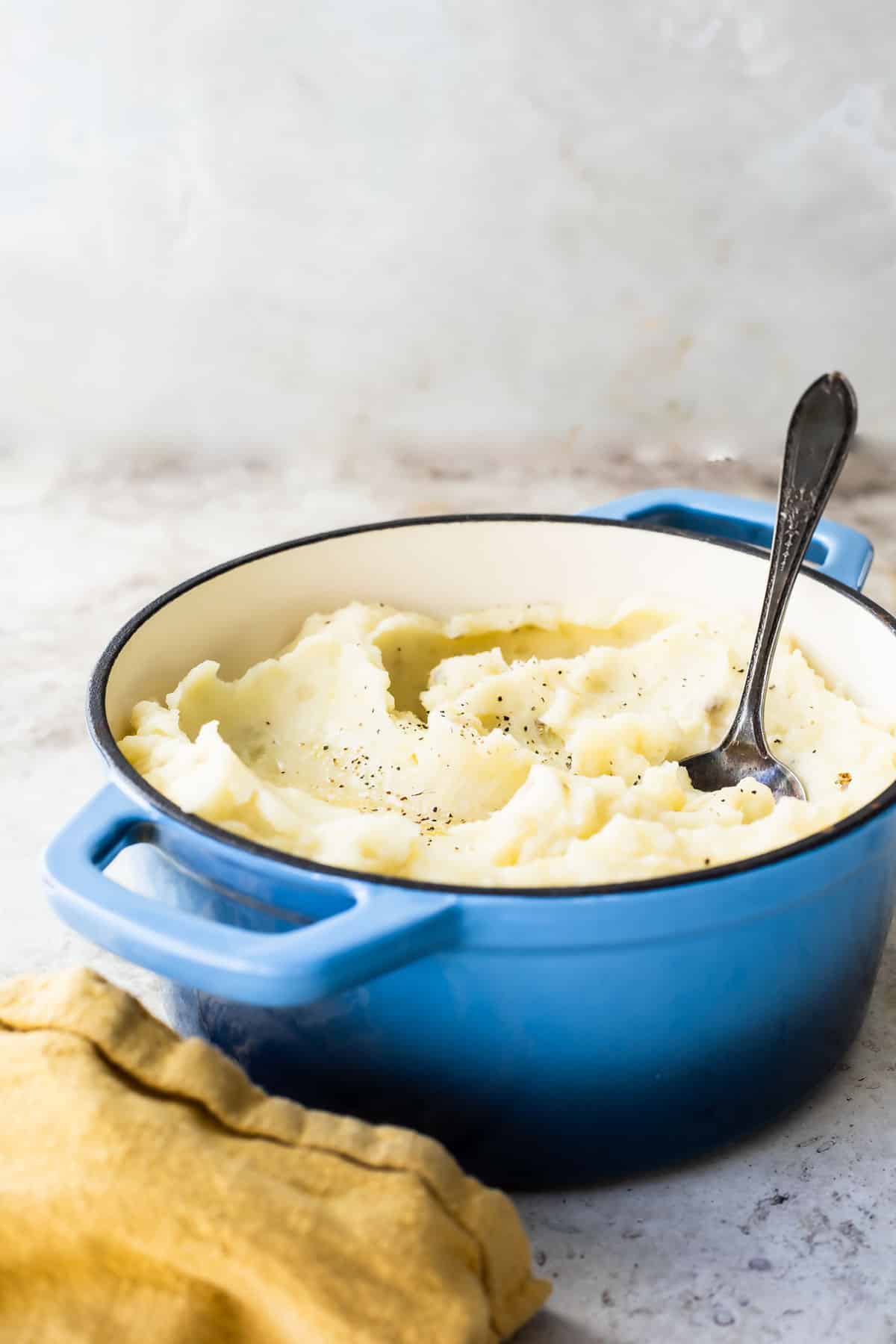
No matter what’s on the menu for the holidays, mashed potatoes should always make an appearance.
There are millions of recipes out there, but if you’re looking for an old-school, classic mashed potato recipe that really lets the flavor of the potato shine, make this one. It is tried and true and absolutely foolproof.
Table of Contents
Recipe ingredients
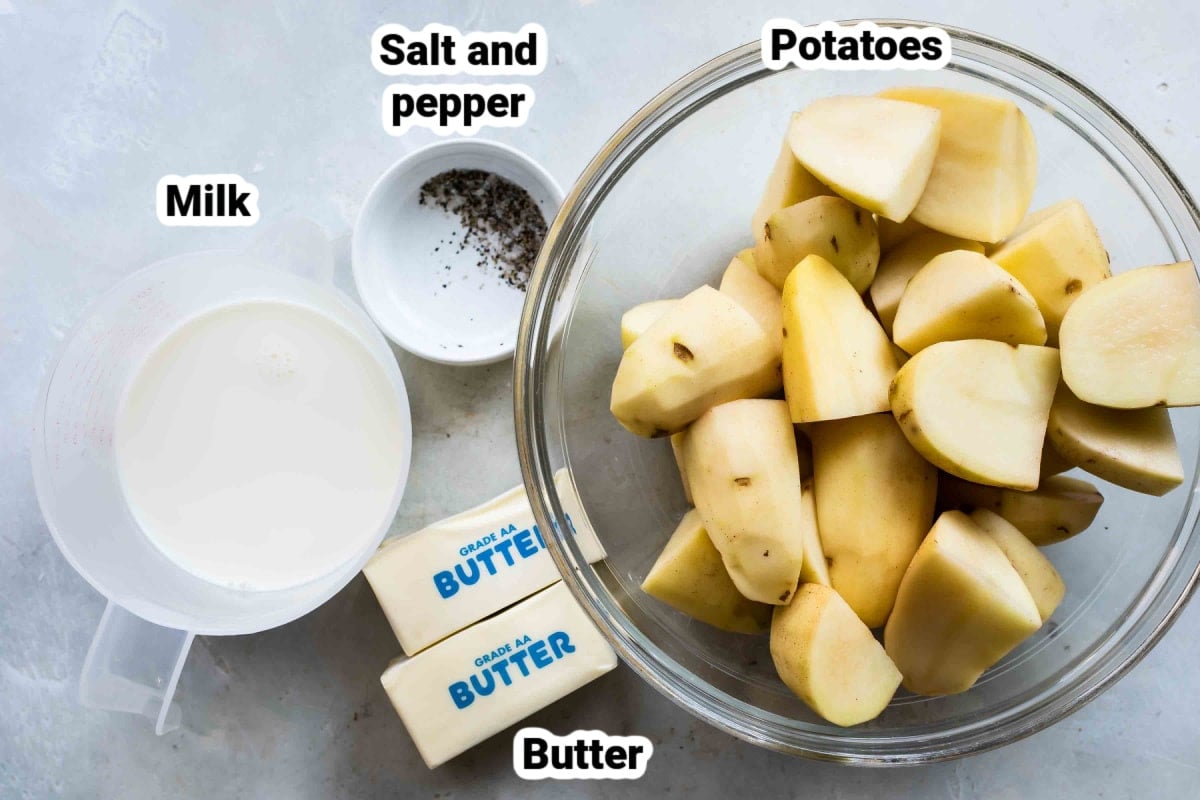
At a Glance: Here is a quick snapshot of what ingredients are in this recipe.
Please see the recipe card below for specific quantities.
Ingredient notes
- Potatoes: For the fluffiest, smoothest, and most flavorful mashed potatoes, choose high-starch potatoes like Russet, Idaho, or Yukon gold potatoes. Waxy potatoes (such as new, red, or white varieties) require more mashing to become creamy which could result in gluey, pasty spuds.
- Butter before milk: Always add the butter first so the butter fat coats the potato starch molecules. Then, add the hot milk to make them creamy. If you mix up the order, you could end up with gluey spuds. (Thanks Cook’s Illustrated for this tip!)
Step-by-step instructions
- In a large pot or saucepan, add potatoes and 2 tablespoons salt. Add cold water to cover potatoes by 1 inch. Over medium-high heat, bring to boil and partially cover pot.
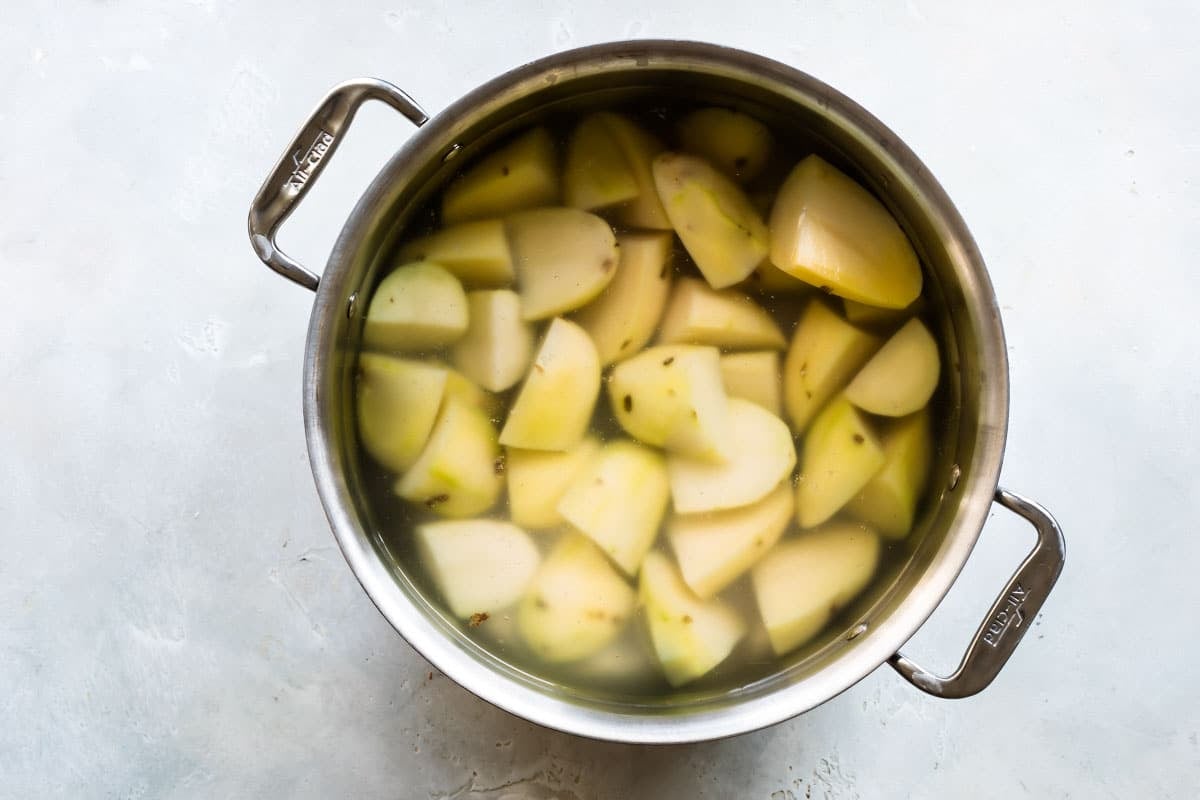
- Cook until potatoes are fork-tender, stirring once or twice, about 10 to 15 minutes. Drain well, tossing in colander to remove excess water.
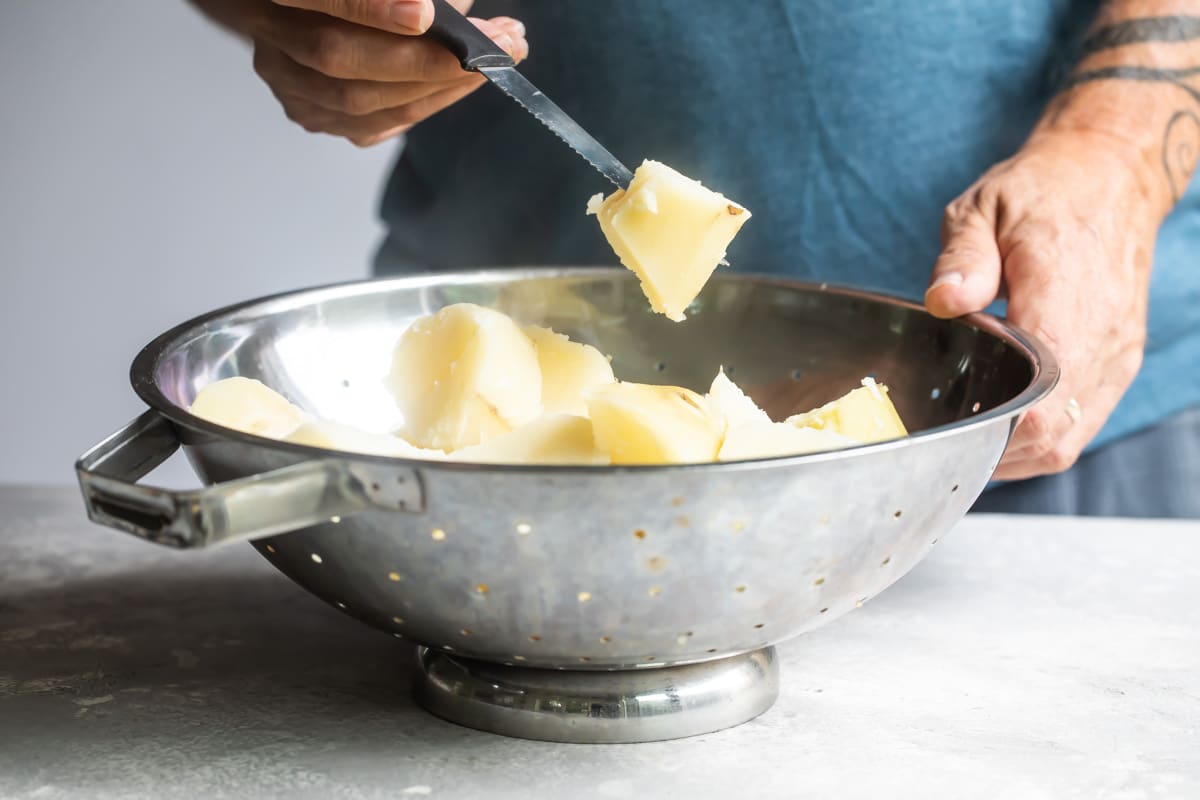
- Wipe pot dry. Return potatoes to pot and mash to a uniform consistency. Using a rubber spatula, fold in melted butter mixture until just incorporated.
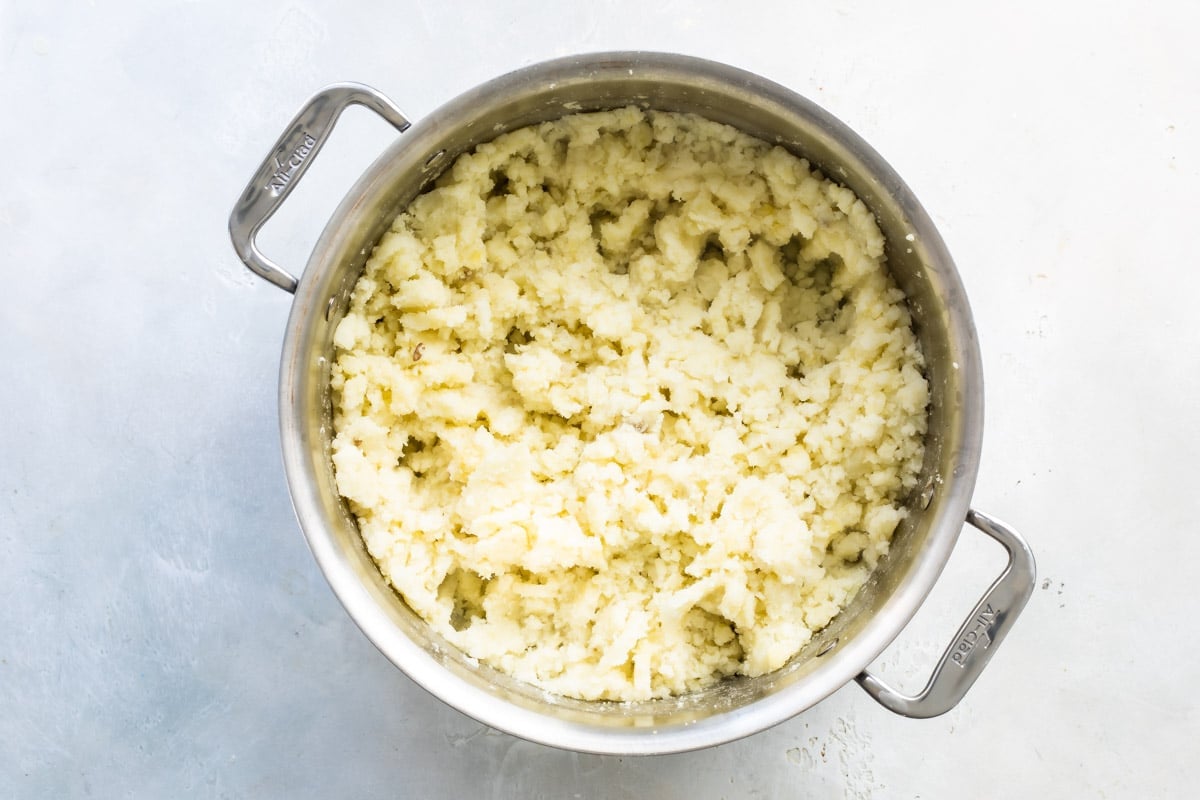
- Slowly stir in 1 ½ cups hot milk. Add more milk, 1 tablespoon at a time, to adjust the consistency as desired.
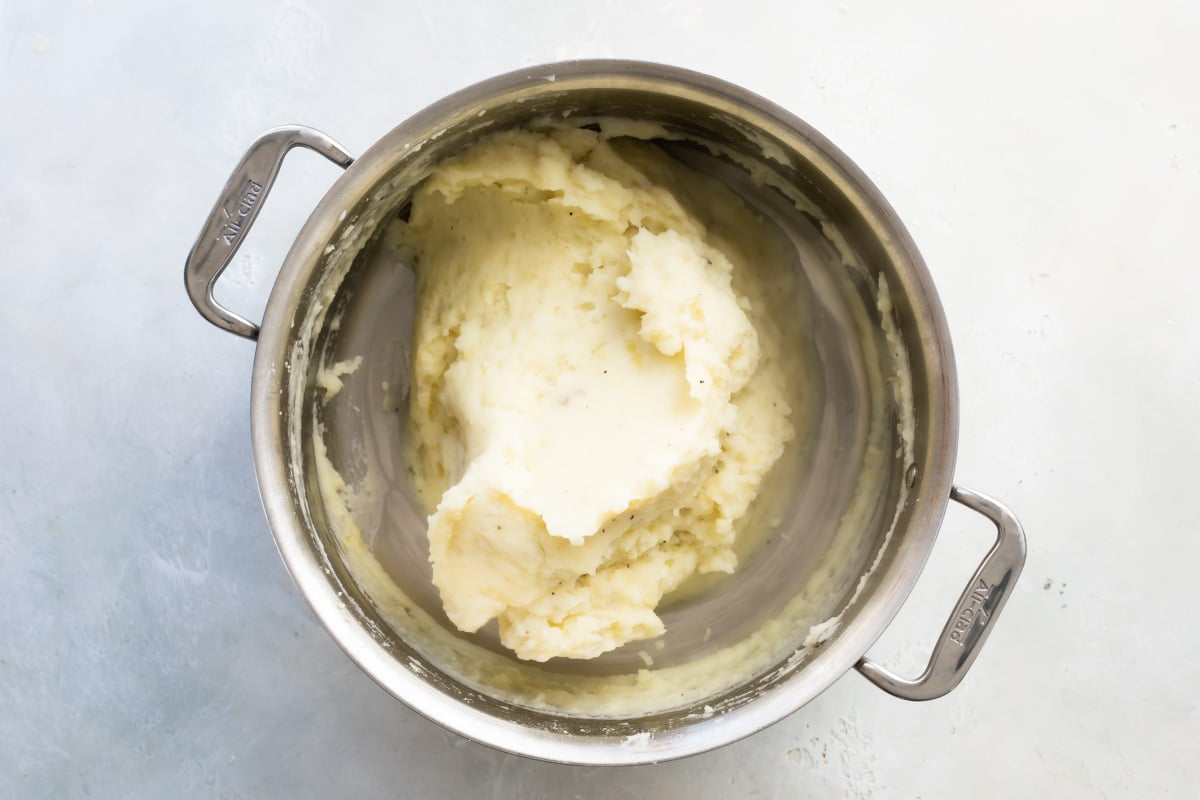
- Season to taste with salt and pepper.
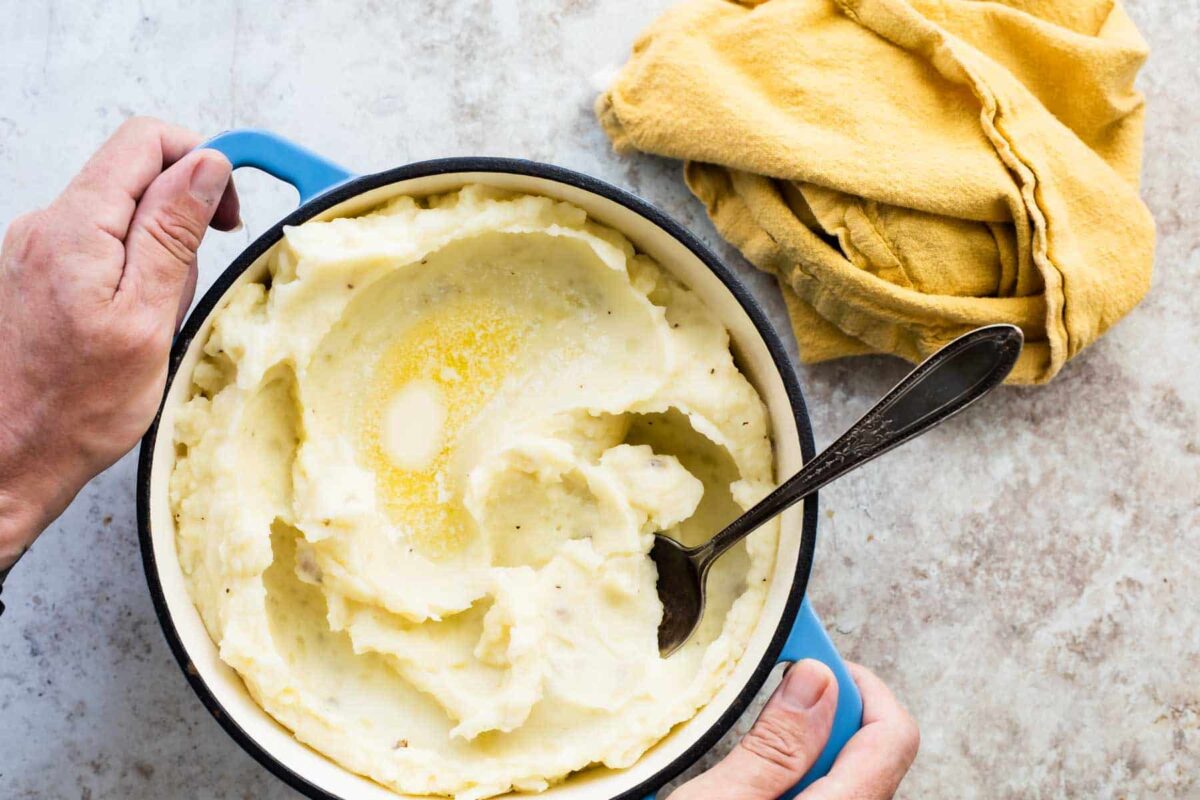
Recipe tips and variations
- Yield: This recipes makes about 12 cups mashed potatoes, enough for 12 (1-cup) servings.
- Storage: Store leftovers covered in the refrigerator for up to 4 days.
- Make ahead: Peel and cube the raw potatoes up to 24 hours in advance. Cover with water and chill in the refrigerator.
- Freezer: Not recommended; mashed potatoes wind up watery and unappetizing after thawing from frozen.
- Speed: For faster cooking, cut the potatoes into smaller, 1-inch pieces.
- Sour cream: For a tangy, creamy mashed potato, stir ½ cup sour cream into the finished mashed potatoes. It tastes great!
- Fresh herbs: Use the extra fresh herbs to make an herb butter to mix into your mashed potatoes, or simply garnish the spuds with a sprinkle of fresh chopped chives.
- Assisted mixing: If you don’t want to mash your potatoes by hand, add them to the bowl of a stand mixer fit with the paddle attachment or an electric mixer.
- Make-Ahead Mashed Potatoes: This freezer-defying recipe uses cream cheese and egg whites for more staying power in the cold, and it’s part of my complete Make Ahead Thanksgiving menu.
- Slow Cooker Mashed Potatoes: Add the peeled, cubed potatoes and 1 ½ cups milk to the bottom of a crock pot. Sprinkle with 1 tablespoon salt, cover, and cook on HIGH for 3 to 4 hours, stirring every hour or so. Mash to a smooth consistency and stir in ½ cup (1 stick) butter until smooth. Season to taste with salt and pepper.
- Instant Pot Mashed Potatoes: Add the peeled, cubed potatoes to the bottom of a pressure cooker. Add cold water to cover and 1 teaspoon salt. Close the lid, set the valve to seal, and cook on manual pressure for 8 minutes. Turn off the instant pot and quick-release the pressure. Drain potatoes well, return to pot, and mash well. Stir in remaining ingredients.
- Garlic Mashed Potatoes: Toast garlic in a skillet (or roast whole bulbs of garlic in the oven), peel, mince, and add to your mashed potatoes. You’ll need about 2 bulbs (40 cloves garlic) for every 5 pounds of potatoes.
- Cauliflower mash: For a low-carb, highly satisfying side dish, try Cauliflower Mashed Potatoes (without a potato in sight).
- Boursin Mashed Potatoes: Soft-skinned small red potatoes mixed with fresh herbs and a block of Boursin cheese. You don’t even have to peel the potatoes!
- Mashed Sweet Potatoes: These mashers are flavored with fresh thyme and a touch of brown sugar. Or try Sweet Potato Casserole with a delicious marshmallow topping.
- Small batch: Making mashed potatoes for your next date night in? Try my scaled-down Mashed Potatoes for Two recipe.
- Irish twist: Colcannon is a delicious version of mashed potatoes with cooked kale or cabbage stirred in. You’ll love that extra texture and color!
- Loaded Mashed Potatoes: Top your mashed potatoes with plenty of shredded cheddar cheese, crispy cooked bacon, and thinly-sliced scallions.
- Potatoes on top: Delicious mashed potatoes are critical for the best possible Shepherd’s Pie.
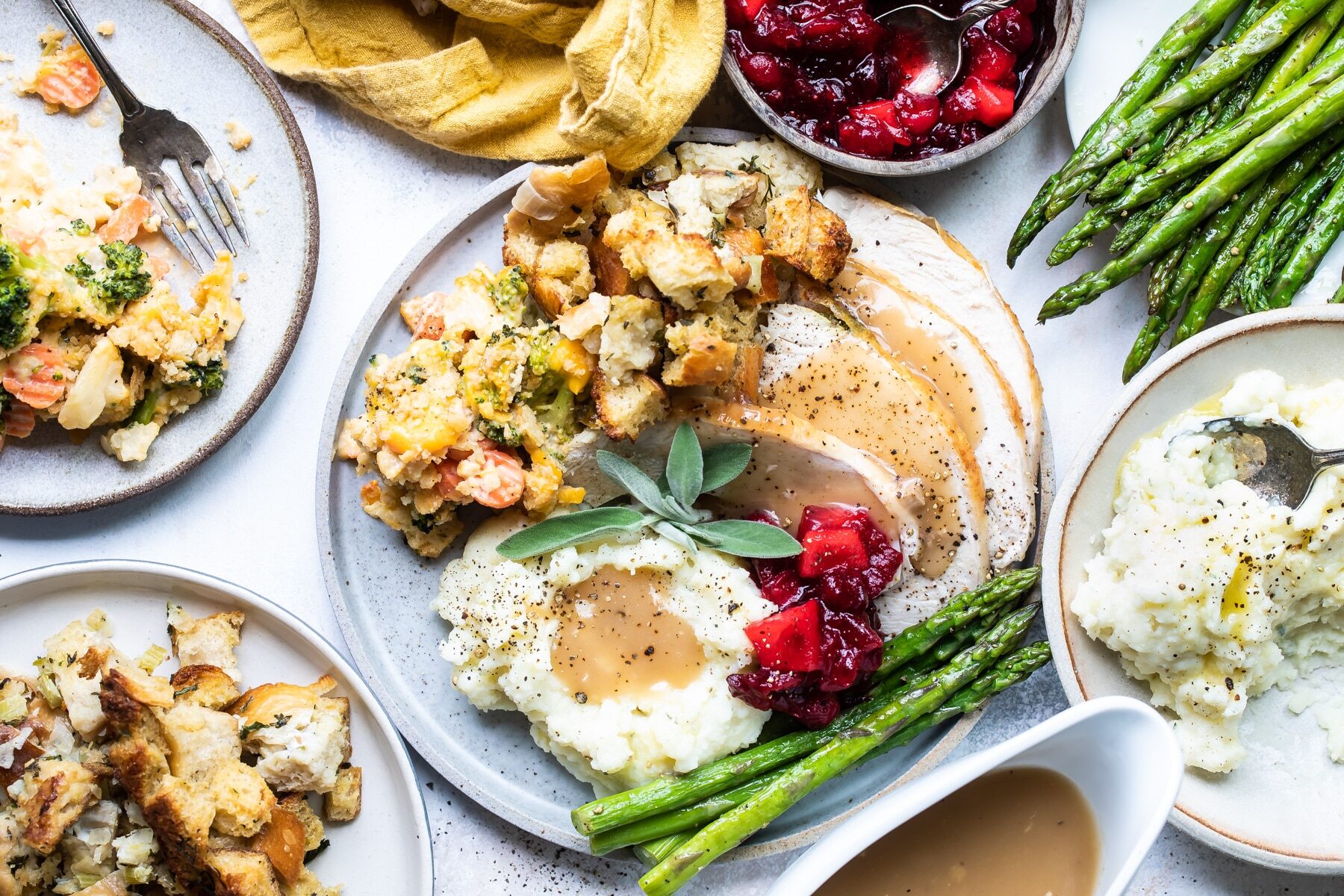
Frequently Asked Questions
Use a basic potato masher. A waffle-head masher will mash the potatoes into a smoother consistency, if you like them somewhere in-between.
Use a potato ricer (peeled potatoes) or food mill (unpeeled potatoes). These gadgets make the smallest, finest pieces of cooked potato, which fluff up beautifully.
Mashed potatoes wind up watery and unappetizing after thawing from frozen (unless the recipe is created for that purpose such as our freezer-defying Make Ahead Mashed Potatoes recipe which uses cream cheese and egg whites for a little more staying power). I don’t recommend that you freeze regular mashed potatoes.
Bake potatoes faster by taking a microwave shortcut:
1. Adjust an oven rack to the middle position and preheat oven to 450 degrees. Poke a few holes in each potato with a fork.
2. Microwave on HIGH power for 8 to 12 minutes, flipping potatoes halfway through the cooking time.
3. Remove the potatoes from the microwave and rub each all over with olive oil, then season generously with salt and pepper.
4. Transfer potatoes to preheated oven and bake directly on oven rack until tender when pierced with a small knife, about 20 minutes longer.
1 raw potato contains about 19g carbohydrates including 15g starch and 2.2g dietary fiber. A potato also contains about 2g protein and 0.1g fat (nearly fat free). Potatoes also contain a host of vitamins and minerals and almost no sodium.

Delicious main dishes
Thanksgiving Recipes
Perfect Roast Turkey
Pork, Ham, and Lamb Recipes
Baked Ham with Crumb Topping
Main Dishes
Pork Roast
Beef Recipes
Roast Beef Tenderloin
Join Us
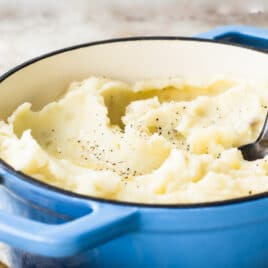
The Best Mashed Potatoes
Ingredients
- 5 pounds russet potatoes peeled and cut into large, uniform sized pieces (see note 1)
- Salt and freshly ground black pepper
- 1 cup butter melted (2 sticks, see note 2)
- 1 1/2 cups milk hot, plus more if desired (up to 2 cups)
Instructions
- In a Dutch oven or large stockpot, add potatoes and 2 tablespoons salt. Add cold water to cover potatoes by 1 inch.
- Over medium-high heat, bring to boil and partially cover pot. Cook until potatoes are tender and a fork can be easily slipped into the center, stirring once or twice, about 10 to 15 minutes. Drain well, tossing in colander to remove excess water.
- Wipe pot dry. Return potatoes to pot and mash to a uniform consistency. Using a rubber spatula, fold in melted butter until just incorporated.
- Slowly stir in 1 ½ cups hot milk. Add more milk, 1 tablespoon at a time, to adjust the consistency as desired. Season to taste with salt and pepper.
Recipe Video
Notes
- Potatoes: For the fluffiest, smoothest, and most flavorful mashed potatoes, choose high-starch potatoes like Russet, Idaho, or Yukon gold potatoes. Waxy potatoes (such as new, red, or white varieties) require more mashing to become creamy which could result in gluey, pasty spuds.
- Butter before milk: Always add the butter first so the butter fat coats the potato starch molecules. Then, add the hot milk to make them creamy. If you mix up the order, you could end up with gluey spuds. (Thanks Cook’s Illustrated for this tip!)
- Yield: This recipes makes about 12 cups mashed potatoes, enough for 12 (1-cup) servings.
- Storage: Store leftovers covered in the refrigerator for up to 4 days.
- Make ahead: Peel and cube the raw potatoes up to 24 hours in advance. Cover with water and chill in the refrigerator.
Nutrition
Meggan Hill is a classically-trained chef and professional writer. Her meticulously-tested recipes and detailed tutorials bring confidence and success to home cooks everywhere. Meggan has been featured on NPR, HuffPost, FoxNews, LA Times, and more.
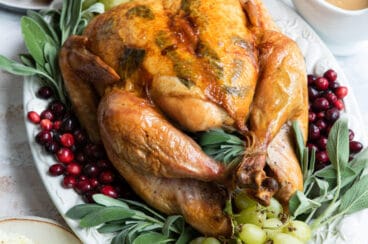
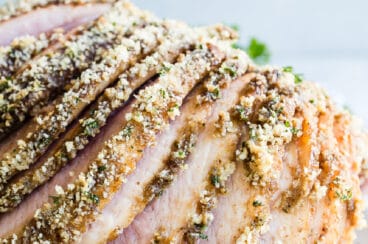
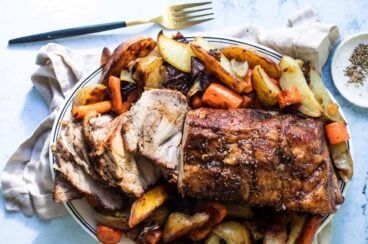
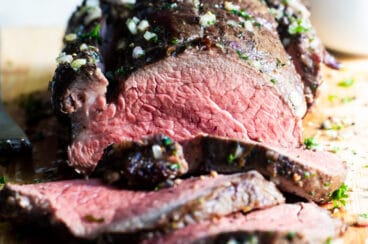
I tried the recipe and it was amazing!!!
It was really soft, not chunky and tasty 😋
I even added parmesan cheese which is optional
I recommend trying this recipe!!!
These were simple and delicious! If we store them for a day or two, what is the best way of reheating them?
Hi Donna, I’m so happy you loved them! I recommend reheating them covered in the oven at 350, or in the microwave, adding a little bit more butter and milk if needed to keep them fluffy and moist. Take care! – Meggan
I would love to make these mashed potatoes, but have always wondered what mixer to use…kitchenAid..handheld..or hand masher??
Thank you!!
Hi Mimi, I usually mash them by hand, unless it’s for a large group, then I will use my standing Kitchen Aid mixer. (Be careful not to over mix them, they will turn out gummy.) I hope you love them! – Meggan
I like it when, regarding amounts of salt and pepper, you say, “I like to use…”. I noticed you didn’t do that in this recipe. You should though. I really appreciate that kind of guidance.
Thanks again for all of your awesome recipes. I’ll be making this one tonight along with your ‘classic meatloaf’ recipe.
#1
Where can I find your Boursin mashed potato recipe?
Hi Melissa, I’m so sorry about that! Somehow a redirect got added so the link wasn’t working (technical jargon). Here it is: https://www.culinaryhill.com/boursin-mashed-potatoes/ Thank you for finding that for me!!!
Like the Barefoot Contessa’s mantra goes, “There’s no such thing as too much butter.” You just taught me something – use hot milk for a creamy finish. Most times I make mine with the jackets on and use a hand masher so they’re lumpy. For guests, I break out the stand mixer. My mom used to use a ricer because she did not have a good mixer with sufficient power to whip the huge amount we would eat at Sunday dinner.
Great recipe – simple with lots of butter!!!